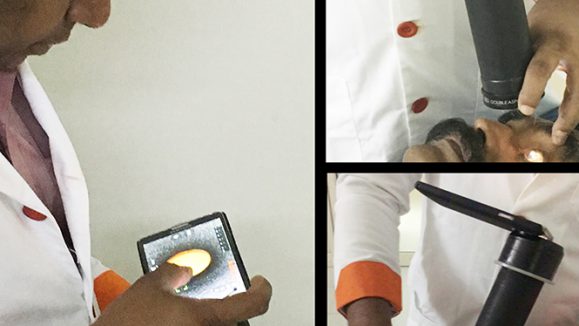Although poets have long said that eyes are the window to the soul, research is showing us that the eyes, more specifically the retinas, are actually windows to the body and brain. The imaging and analysis of retinal blood vessels has lead to the discovery of new biomarkers in retinal diseases such as diabetic retinopathy, central retinal vein occlusion, retinitis pigmentosa, and glaucoma. Beyond ocular diseases, because retinal blood vessels are part of central nervous system vasculature, biomarkers for diseases of the brain, such as Alzheimer’s disease are also being uncovered. This work is being done using retinal oximetry and is based on spectrophotometric fundus imaging which measures oxygen saturation in arterioles and venules in the retinal vasculature, retina, and optic nerve head. This non-invasive, quick, safe technique can detect changes in oxygen metabolism, including those that result from ischemia or atrophy.
In a recent special issue of Investigative Ophthalmology & Visual Sciences, Dr. EinarStefánsson, M.D., Ph.D., FARVO, and colleagues discuss the clinical applications of retinal oximetry and the latest discoveries of biomarkers in retinal and brain diseases. Dr. Stefánsson explains, “Retinal oximetry adds a new dimension to diagnostic imaging of the eye, which previously has been limited to structural functional/electric imaging. Retinal oximetry is metabolic imaging. Many retinal diseases have metabolic foundations and involve ischemia and/or atrophy.”
In ischemic/hypoxic retinopathies such as diabetic retinopathy, neovascular, age-related macular degeneration, and retinal vein occlusions, retinal oximetry measures retinal hypoxia directly or indirectly. Retinal hypoxia is the main stimulant for production of vascular endothelial growth factor (VEGF).
As we know, VEGF is the primary treatment target in these diseases and also the predominant cause of retinal edema and neovascularization, resulting in reduced vision. Dr. Stefánsson explains, “Hypoxia is ideal as a biomarker in these diseases as it relates so closely to VEGF which is central in the pathophysiology and treatment.”
“Since retinal hypoxia is closely linked to VEGF production, this biomarker is likely to be useful for determining the need for anti-VEGF treatment or hypoxia relieving treatment such as laser and vitrectomy,” he added.
Both laser and vitrectomy influence retinal oxygen metabolism, an effect that can be detected by retinal oximetry. Retinal photocoagulation destroys photoreceptors and adjacent tissue and reduces oxygen consumption of retina, reducing hypoxia and VEGF production. “Retinal oximetry evaluates the outcome of such treatments in terms of the pathophysiology process rather than waiting for structural and functional damage which comes later,” explained Dr. Stefánsson.
Additionally, in atrophic retinal diseases, such as retinitis pigmentosa and other retinal dystrophies, glaucoma and atrophic age related macular degeneration, retinal atrophy leads to reduced oxygen consumption, which can also be detected by retinal oximetry. Therefore, retinal oximetry offers a non-invasive method to measure the progression of these diseases and the need for, or response to treatment.
The response to treatment can also be valuable in the assessment of new therapies, as Dr. Stefánsson describes, “Retinal oximetry can also be used to determine the improvement from new and experimental therapies in terms of new viable cells consuming oxygen.”
Reference:
Stefánsson E, Olafsdottir OB, Einarsdottir AB, et al. Retinal Oximetry Discovers Novel Biomarkers in Retinal and Brain Diseases. Invest Ophthalmol Vis Sci. 2017;58(6):BIO227-BIO233.




